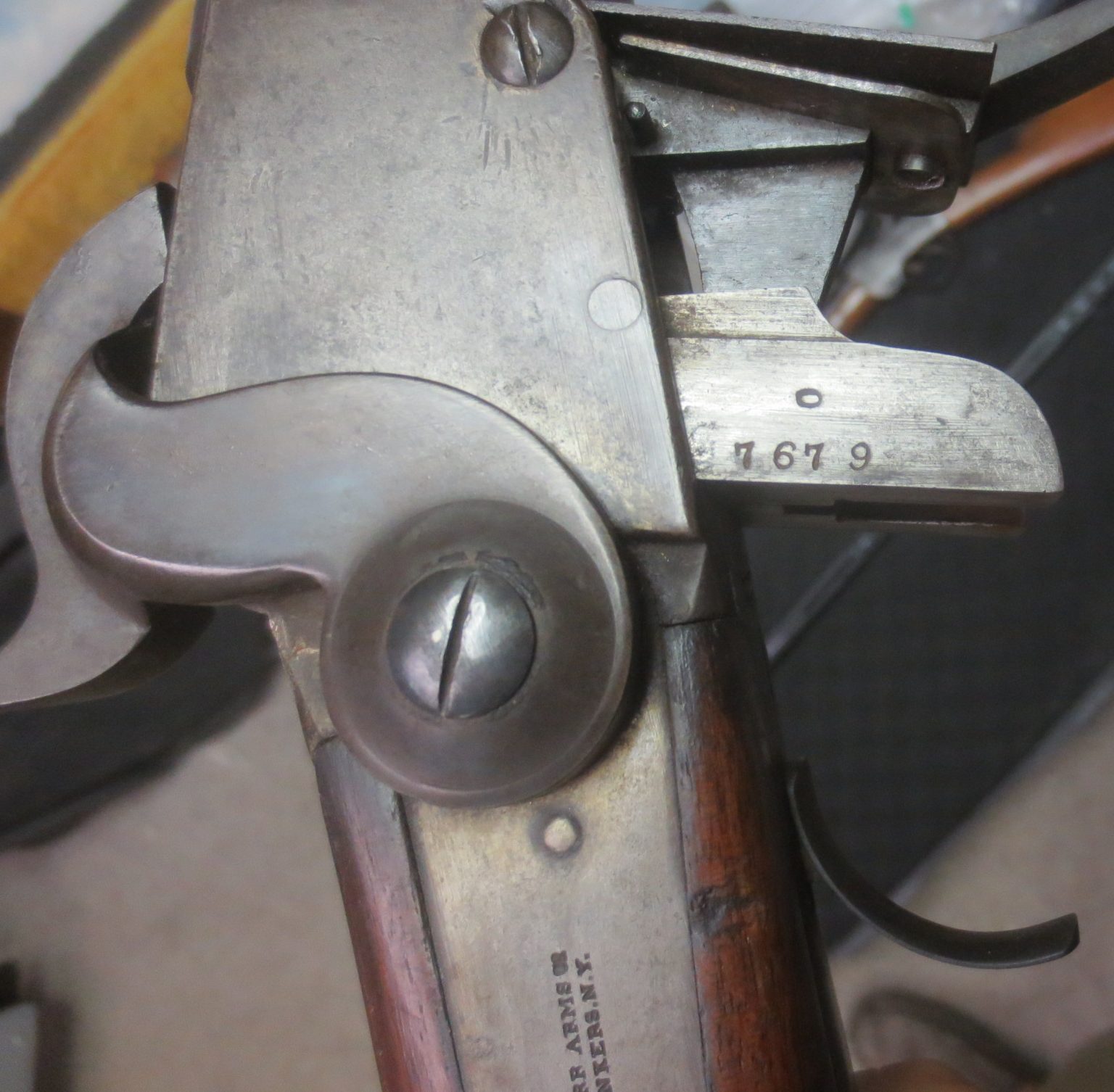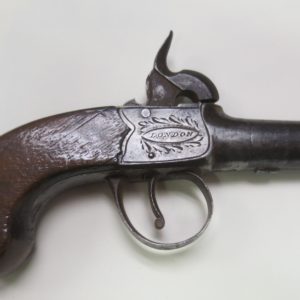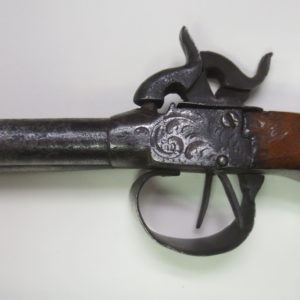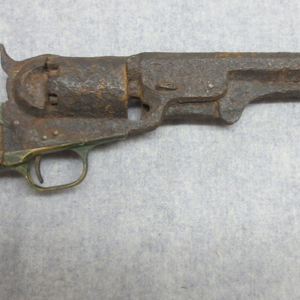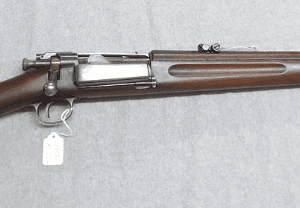Description
This is a near excellent original example of this well respected Civil War Union cavalry weapon. The barrel retains almost 95% original blue and the bore is excellent (just a bit dirty from many years of storage). This fine weapon recently was found in an estate near Harrisburg, Pennsylvania but unfortunately the family history had been lost decades ago.
Issued to the Federal cavalry during the Civil War, this weapon is a fine example of a Starr carbine, which is a breech loading, .54 caliber percussion weapon produced by the Starr Arms Company of Yonkers, New York. The Starr carbine resembled the more famous ‘Sharps’ carbine of the time but the Union cavalrymen did not think as highly of the Starr as they did the Sharps. The first shipment of 1000 Starr percussion carbines was delivered to the Ordnance Department in September 1863, and in total over 20,000 such weapons were ultimately purchased by the US government.
Manufactured between 1862 and 1865, the Starr percussion carbines were all .54 caliber breechloaders fitted with a 21” long, round tapered barrel. The carbine employed a split breech, drop block mechanism that allowed the trooper to insert a linen cased cartridge into the chamber of the breech. The upward motion of the operating lever / triggerguard closed the breech and ignition was activated with the striking of a percussion cap by the external hammer. The weapon measures 37½” long and weighs 7 lbs. and 6 ounces. The iron lockplate and frame were casehardened and the barrel blued.
This original carbine bears serial #7679 and features a two-piece black walnut stock with an 8” long fore-end secured by a single brass barrel band. It has a 14½” long buttstock with a brass buttplate.
Some case colors remain on the lock and the barrel retains 95% original finish. Maker stamp impressions on the lockplate are clear and read, “STARR ARMS CO. / YONKERS, N.Y.” in two lines. The barrel surface has a thin, one-line marked “STARR ARMS CO. YONKERS, N.Y.” in front of the rear sight. The receiver tang in back of the hammer is stamped with “STARR’S PATENT / SEPT. 14th 1858”. A single iron sling ring is mounted on the left side of the receiver.
All mechanics are crisp and firm. There is very light pitting around nipple and at the top of the breech.
The wooden stocks lack the normal dings and surface nicks normally encountered and is in exceptional overall condition. No cracks are visible and the outline of the original government inspector cartouche is visible. The carbine frame screws are crisp and free of blemishes or buggering.
This is an excellent representative example of a percussion carbine carried by Union cavalry the serial number places it in the range of the 14th Pennsylvania Cavalry as documented by the Springfield Research Service database.
14th Regiment, Pennsylvania Cavalry (originally designated as the 159th Volunteers)
OVERVIEW:
Organized at Pittsburg, Philadelphia and Erie October and November, 1862. Moved to Hagerstown, Md., November 24, 1862, thence to Harper’s Ferry, W. Va., December 28. Attached to Defences Upper Potomac, 8th Army Corps, Middle Department, to March, 1863. 1st Brigade, 1st Division, 8th Corps, March, 1863. 4th Separate Brigade, 8th Corps, to June, 1863. Averill’s 4th Separate Brigade, Dept. West Virginia, to December, 1863. 2nd Brigade, 4th Division, Dept. West Virginia, to April, 1864. 2nd Brigade, 2nd Cavalry Division, West Virginia, to June, 1864. 1st Brigade, 2nd Cavalry Division, West Virginia, to August, 1864. 3rd Brigade, 1st Division, Cavalry Corps, Army Shenandoah, Middle Military Division, August, 1864. 1st Brigade, 2nd Cavalry Division, West Virginia, to April, 1865. 1st Separate Brigade, 22nd Corps, Dept. of Washington, to June, 1865. Dept. of Missouri to August, 1865.
SERVICE:
Picket and outpost duty in the vicinity of Harper’s Ferry, W. Va., till May, 1863. Scout to Leesburg March 15 and April 21-24, 1863. Ordered to Grafton, W. Va., May, 1863, and duty protecting Phillippi, Beverly and Webster till July. Forced march to relief of Beverly July 2-3. Huttonsville July 4. Moved to Webster, thence to Cumberland, Md., and to Williamsport, Md., July 5-14, and join Army of the Potomac. Advance to Martinsburg July 15. Martinsburg and Hedgesville July 18-19. McConnellsburg, Pa., July 30. Averill’s Raid from Winchester through Hardy, Pendleton, Highland, Bath, Greenbrier and Pocahontas Counties, W. Va., August 1-31. Newtown August 2. Moorefield and Cacapon Mountain August 6 (Detachment). Salt Works, near Franklin, August 10. Jackson River August 25. Rocky Gap, near White Sulphur Springs, August 26-27. Hedgesville October 15 (Detachment). Averill’s Raid against Lewisburg and the Virginia & Tennessee Railroad November 1-17. Cackletown November 4. Mill Point November 5. Droop Mountain November 6. Averill’s Raid from New Creek to Salem, on Virginia & Tennessee Railroad, December 8-25. Marling’s Bottom Bridge December 11. Gatewood’s December 12. Descent upon Salem December 16. Scott’s or Barber’s Creek December 19. Jackson River, near Covington. December 19. Winchester March 22 and April 8, 1864. Sigel’s Expedition from Martinsburg to New Market April 23-May 16 (Detachment). Averill’s Raid on Virginia & Tennessee Railroad May 5-19. Grassy Lick, Cove Mountain, near Wytheville, May 10. New River Bridge May 10. New Market May 15 (Detachment). Hunter’s Expedition to Lynchburg May 26-July 1. Piedmont, Mount Crawford, June 5. Occupation of Staunton June 6. (Detachment with Sigel rejoined Regiment at Staunton.) Lexington June 11. Scout around Lynchburg June 13-15. Near Buchanan June 13. New London June 16. Diamond Hill June 17. Lynchburg June 17-18. Liberty June 19. Buford’s Gap June 20. Catawba Mountains and about Salem June 21. Liberty June 22. Moved to the Shenandoah Valley July. Buckton July 17. Stephenson’s Depot July 20. Newtown July 22. Kernstown, Winchester, July 24. Near Martinsburg July 25. Hagerstown July 29. Hancock, Md., July 31. Antietam Ford August 4. Sheridan’s Shenandoah Valley Campaign August to November. Near Moorefield August 7. Williamsport, Md., August 26. Martinsburg August 31. Bunker Hill September 2-3. Winchester September 5. Darkesville September 10. Bunker Hill September 13. Near Berryville September 14. Opequan, Winchester, September 19. Fisher’s Hill September 22. Mount Jackson September 23-24. Forest Hill or Timberville September 24. Brown’s Gap September 26. Weyer’s Cave September 26-27. Mount Jackson October 3 (Detachment). Battle of Cedar Creek October 19. Dry Run October 23 (Detachment). Milford October 25-26. Cedar Creek November 8. Nineveh November 12. Rude’s Hill November 23. Snicker’s Gap November 30. Millwood December 17 (Detachment). Expedition from Winchester to Gordonsville December 19-28. Madison C. H. December 21. Liberty Mills December 22. Near Gordonsville December 23. At Winchester till April, 1865. Expedition into Loudoun County February 18-19 (Detachment). Expedition to Ashby’s Gap February 19. Operations in the valley till April 20. Ordered to Washington, D. C., April 20, and duty there till June. Grand Review May 23-24. Moved to Fort Leavenworth, Kan., June, and duty in the District of the Plains till August. Mustered out August 24, 1865.
The regiment lost, during service, 2 Officers and 97 Enlisted men killed and mortally wounded and 296 enlisted men by disease. Total 395.


